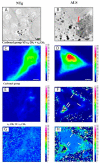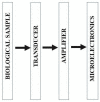Advanced Waveguide Based LOC Biosensors: A Minireview
- PMID: 35891123
- PMCID: PMC9323137
- DOI: 10.3390/s22145443
Advanced Waveguide Based LOC Biosensors: A Minireview
Abstract
This mini review features contemporary advances in mid-infrared (MIR) thin-film waveguide technology and on-chip photonics, promoting high-performance biosensing platforms. Supported by recent developments in MIR thin-film waveguides, it is expected that label-free assimilated MIR sensing platforms will soon supplement the current sensing technologies for biomedical diagnostics. The state-of-the-art shows that various types of waveguide material can be utilized for waveguide spectroscopic measurements in MIR. However, there are challenges to integrating these waveguide platforms with microfluidic/Lab-on-a-Chip (LOC) devices, due to poor light-material interactions. Graphene and its analogs have found many applications in microfluidic-based LOC devices, to address to this issue. Graphene-based materials possess a high conductivity, a large surface-to-volume ratio, a smaller and tunable bandgap, and allow easier sample loading; which is essential for acquiring precise electrochemical information. This work discusses advanced waveguide materials, their advantages, and disease diagnostics with MIR thin-film based waveguides. The incorporation of graphene into waveguides improves the light-graphene interaction, and photonic devices greatly benefit from graphene's strong field-controlled optical response.
Keywords: LOC devices; graphene incorporation; mid-infrared; waveguides.
Conflict of interest statement
The authors declare no conflict of interest.
Figures















References
-
- Parachalil D.R., Bruno C., Bonnier F., Blasco H., Chourpa I., Baker M.J., McIntyre J., Byrne H.J. Analysis of bodily fluids using vibrational spectroscopy: A direct comparison of Raman scattering and infrared absorption techniques for the case of glucose in blood serum. Analyst. 2019;144:3334–3346. doi: 10.1039/C9AN00125E. - DOI - PubMed
-
- Fahrenfort J. Attenuated total reflection: A new principle for the production of useful infra-red reflection spectra of organic compounds. Mol. Spectrosc. 1989;45((Suppl. S41)):251–263.
-
- Harrick N.J., Beckmann K.H. Internal Reflection Spectroscopy. In: Kane P.F., Larrabee G.B., editors. Characterization of Solid Surfaces. Springer; Boston, MA, USA: 1974. pp. 215–245.
Publication types
MeSH terms
Substances
Grants and funding
LinkOut - more resources
Full Text Sources
Miscellaneous

